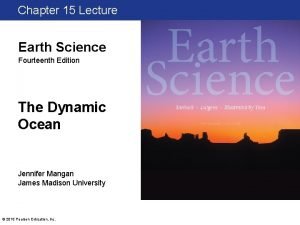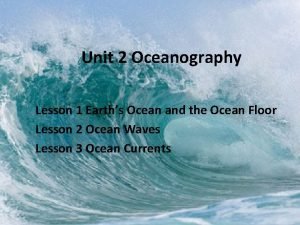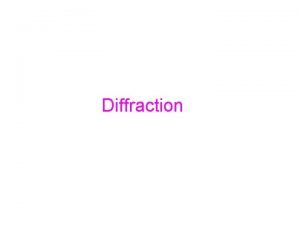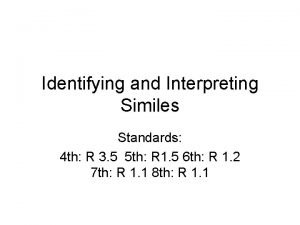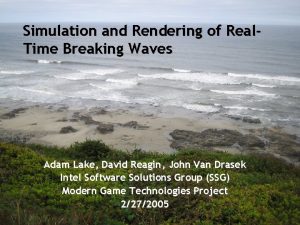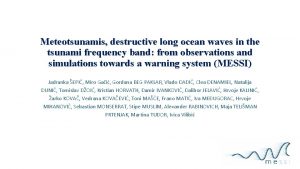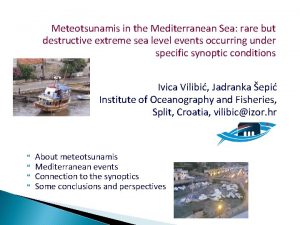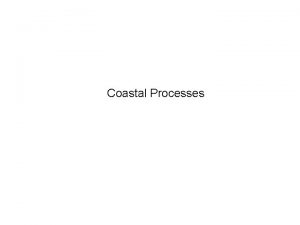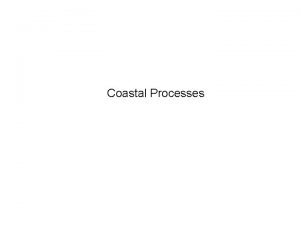MESSI Meteotsunamis destructive long ocean waves in the


















- Slides: 18

MESSI - Meteotsunamis, destructive long ocean waves in the tsunami frequency band: from observations and simulations towards a warning system Jadranka Šepić1 (sepic@izor. hr), Ivica Vilibić1, Miroslav Gačić2, Hrvoje Mihanović1, Clea Denamiel 1, Sebastian Monserrat 3, Alexander Rabinovich 4, Martina Tudor 5, Damir Ivanković1, Kristian Horvath 5, Gordana Beg Paklar 1, Vedrana Kovačević2, Tomislav Džoić1, Žarko Kovač1, Stipe Muslim 1, Dalibor Jelavić1, Hrvoje Kalinić6, Vlado Dadić1, Toni Mašće 1 Institute of Oceanography and Fisheries (Split, Croatia) 2 Istituto Nazionale di Oceanografia e di Geofisica Sperimentale (Trieste, Italy) 3 University of the Balearic Islands (Palma de Mallorca, Spain) 4 International Tsunami Research, Inc. (Victoria, BC, Canada) 5 Meteorological and Hydrological Service (Zagreb, Croatia) 6 Faculty of Science, University of Split (Split, Croatia) 1

MESSI project • Project Title: Meteotsunamis, destructive long ocean waves in the tsunami frequency band: from observations and simulations towards a warning system (MESSI) • Principal Investigator: Jadranka Šepić • Co-Principal Investigator: Miroslav Gačić • Funding: Unity Through Knowledge Fund • Budget: 1. 806. 395, 11 HRK (1. 353. 295, 11 HRK - UKF) • Project Duration: 15 December 2015 – 14 December 2017 • Involved Institution: Institute of Oceanography and Fisheries (Split, Croatia); Istituto Nazionale di Oceanografia e di Geofisica Sperimentale (Trieste, Italy); Meteorological and Hydrological Service (Zagreb, Croatia); University of the Balearic Islands (Palma de Mallorca, Spain); International Tsunami Research, Inc. (Victoria, BC, Canada)

MESSI project - motivation Meteotsunamis are a global phenomena and an ever present threat for numerous coastal communities around the World. The strongest known meteotsunami up to date is the Great Vela Luka Flood of 21 June 1978.

MESSI project – main objective • Meteotsunamis can cause extensive damage: especially endangered are middle Adriatic harbours: Vela Luka, Stari Grad, Vrboska, Mali Ston. • Adriatic meteotsunamis commonly occur in summer – when coastal population increases several times: higher chance of injury and panic! • Practical and operational component (meteotsunami forecast and warnings) significantly lags for the scientific component! • The main objective of the MESSI project is therefore to build a reliable prototype of a meteotsunami warning system based on real time measurements, operational atmosphere and ocean modelling and real time decision-making process.

MESSI project – other objectives 1) Supporting and supplementing operational oceanographic products and services currently developed at the national level 2) Using a novel approach and techniques for tracking and forecasting potentially hazardous events 3) Collaborating and networking with top-level international scientists 4) Transfer of knowledge to Ph. D students and post-docs 5) Transfer of knowledge to engineers 6) Helping vulnerable local communities 7) Examining various aspects of meteotsunamis like: I. III. IV. V. Generation of meteotsunamis over complex bathymetry Propagation and interaction of free and forced ocean waves Transfer of energy from atmosphere to the sea Refraction and reflections of free waves Other. . .

MESSI project - tasks • Task 1. Assessment of historical Adriatic meteotsunamis • Task 2. Design and construct of a meteotsunami monitoring station prototype • Task 3. Installation of a meteotsunami research and warning network • Task 4. Estimate occurrence rate of meteotsunamis in the past, present and future climate • Task 5. Mapping of meteotsunami hazard and creation of meteotsunami warning matrices • Task 6. Set up of operational atmospheric and ocean models • Task 7. Set up a prototype of warning system • Task 8. Create dynamic web content with a meteotsunami hazard forecast • Task 9. Dissemination towards potential users

Task 1. Assessment of historical Adriatic meteotsunamis The most prominent and devastating historical Adriatic meteotsunamis will be investigated using available atmospheric data and tide-gauge records both from Croatian and Italian Adriatic coast. Historical events will be reproduced with state-ofthe art numerical ocean and weather models. Maximum modelled wave heights, real forcing (VL air pressure) Šepić et al. , 2016 (PAGEOPH) Milestone 1. Historical meteotsunamis revaluated and reproduced (month 8). Meteotsunami events of 25 & 26 June 2014 have been researched in details and reproduced with both ocean (SELFE-SCHISM) and atmospheric (WRF) models. A paper on the events has been published: Šepić et al. , 2016 (PAGEOPH).

Task 1. Assessment of historical Adriatic meteotsunamis Milestone 2. Numerical models assessed and fine tuned (month 12). Numerical models are being set up at the moment; two meteorological models (ALADIN HR 22 and ALADIN HR 44 have been set up, one more – WRF is being set up, and ocean ROMS-ADCIRC model is being set up) Mean sea level pressure field - output from operational ALADIN HR 22 model

Task 2. Design and construct of a meteotsunami monitoring station prototype A prototype of meteotsunami monitoring station will be build, requiring non-standard approach and setup. Two station prototypes will be created by the IOF engineers: atmospheric station, and ocean-atmospheric station which will be further equipped with the sea level sensor. Air pressure measurements done using prototype of a Milestone 3. Meteotsunami monitoring station meteorological meteotsunami station. prototypes built and ready to use (month 12). Prototype of meteotsunami atmospheric station has been built and is currently installed at Vrboska (Hvar). Measuring instruments (tide gauges, air pressure sensors, wind sensors) necessary for building meteotsunami monitoring stations have been purchased.

Task 3. Installation of a meteotsunami research and warning network Meteotsunami monitoring stations will be installed at the selected eastern (Vela Luka, Vis, Stari Grad, Palagruža, Šolta, Svetac) and western middle Adriatic locations (Tremiti, Ortona, Vieste). Milestone 4. Meteotsunami research and warning network operational (month 15). Search for optimal locations for meteotsunami stations is underway. Contacts with local authorities are being established.

Task 4. Estimate occurrence rate of meteotsunamis in the past, present and future climate Favourable synoptic conditions for appearance of meteotsunamigenic air pressure disturbances will be determined using ERA-Interim atmospheric reanalysis (ECMWF) web portal. Using state-of-the art pattern recognition methods, favourable synoptic conditions will be extracted from past and future climate simulations. Strongest air pressure events (2009 – 2016) Milestone 6. Air pressure time series statistically analysed, favourable synoptic conditions determined (month 15). Sebastien Delort, a French student from University of Toulon has analysed air pressure time series and determined favourable synoptic conditions for meteotsuanami appearance over the Adriatic.

Task 4. Estimate occurrence rate of meteotsunamis in the past, present and future climate Milestone 7. Frequency of meteotsunami events in past and future determined from atmospheric reanalysis and climate models (month 21). A paper which deals with the scientific background of the procedure has been accepted for publication: Šepić, J. , Vilibić, I. , Monserrat, S. , 2016. Quantifying the probability of meteotsunami occurrence from synoptic atmospheric patterns. Geophysical Research Letters, doi: 10. 1002/2016 GL 070754. A link between meteotsunami wave height and synoptic conditions Šepić et al. , 2016 (GRL)

Task 5. Mapping of meteotsunami hazard and creation of meteotsunami warning matrices Historic meteotsunami data and numerical ocean model outputs will be used to map meteotsunami hazard over the Adriatic coast. Maximum wave height Šepić et al. , 2016 (PAGEOPH) Proudman length Milestone 8. Maps of present and future meteotsunami hazard created (month 16). Milestone 9. Meteotsunami warning matrices created for the most endangered areas (month 20). Both milestones will be realized after completing Milestone 2 (Task 1) and Milestone 6 (Task 4).

Task 6. Set up of operational atmospheric and ocean models ALADIN/HR mesoscale numerical model will be run operationally at the Meteorological and Hydrological Service. Automatic procedures for recognition of meteotsunami favourable synoptic conditions will be created. Non-structured ocean numerical model will be used to predict ocean response. Mesh for ADCIRC ocean numerical model – Vela Luka zoom in Milestone 10. An operational atmospheric and ocean model fields available and automatically analyzed in real time for extraction of meteotsunami favourable conditions (month 18). Two out of four planned atmospheric and ocean models have been set up, and others are currently being set up.

Task 7. Set up a prototype of warning system A warning system based on real-time air pressure measurements and results of atmospheric and ocean numerical model will be created in close collaboration with the project Co-PI. Procedures and algorithms for determining a level of danger will be developed. Milestone 11. A prototype of meteotsunami warning system established (month 20). Milestone will be realized after completing Task 2, Task 3, Task 4, Task 5 and Task 6. A paper on the subject has been published: Vilibić et al. , 2016 (Frontiers in Marine Sciences) Warning system schematic Vilibić et al. , 2016 (Frontiers)

Task 8. Create dynamic web content with a meteotsunami hazard forecast Project web pages will be developed at the beginning and updated throughout the project. At its final stage, project web pages will contain real-time data from the warning and research network, relevant outputs of numerical atmospheric and ocean models, meteotsunami warning matrices, and estimates of meteotsunami hazard. MESSI web page Milestone 12. Dynamic web content with meteotsunami danger warning created (month 22). Project web page which will in future contain meteotsunami danger warning has been created: http: //www. izor. hr/messi. Meteotsunami danger warning module will be added after completing Tasks 2 -7.

Task 9. Dissemination towards potential users Dissemination of project results will be directed towards: (i) national government authorities, operational services and civil protection agencies, (ii) local authorities, (iii) international programmes and projects. Milestone 13. The information on project results and application possibilities will be systematically disseminated to potential users (months 12 -24). Project and first project results have been presented at the EGU meeting in Vienna (17 - 22 April 2016), CIESM meeting in Kiel (12 – 16 September), at two meetings of scientific research organizations (European Marine Board and Euro. GOOS Initiative), and three scientific papers have been published or accepted for publication. Milestone 14. Stakeholder workshop organized (month 24). Milestone will be realized towards the end of the project.

Questions?
 Aimtoknow
Aimtoknow What is a semiconductor used for
What is a semiconductor used for Tall + short h
Tall + short h Once upon a time,there
Once upon a time,there Từ ngữ thể hiện lòng nhân hậu
Từ ngữ thể hiện lòng nhân hậu Red ocean strategi
Red ocean strategi Convergent ocean to ocean
Convergent ocean to ocean Chapter 15 ocean water and ocean life wordwise answer key
Chapter 15 ocean water and ocean life wordwise answer key Ocean ocean convergent boundary
Ocean ocean convergent boundary Scrat s continental crack up
Scrat s continental crack up Ocean to ocean convergent boundary
Ocean to ocean convergent boundary Ocean to ocean convergent boundary
Ocean to ocean convergent boundary Ocean ocean convergent boundary
Ocean ocean convergent boundary Ocean waves
Ocean waves Citlalli dominguez
Citlalli dominguez Ocean waves
Ocean waves The phenomenon of diffraction can be understood using *
The phenomenon of diffraction can be understood using * Beach similes
Beach similes Breaking waves
Breaking waves













